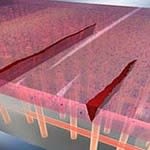 A team led by Christoph Weder, a materials scientist at the University of Fribourg in Switzerland, has developed a type of rubbery plastic that “self heals” when exposed to ultraviolet light. The material might one day be incorporated into varnish, paint or mobile phone covers.
A team led by Christoph Weder, a materials scientist at the University of Fribourg in Switzerland, has developed a type of rubbery plastic that “self heals” when exposed to ultraviolet light. The material might one day be incorporated into varnish, paint or mobile phone covers."Just try to imagine how the lifetime of many items could be prolonged if damage could be fixed so easily," said Weder.
Self-healing materials are not totally new. Many rubbery thermoplastics can be heated until they begin to melt, so that liquid plastic flows into the damaged area before hardening again. But this is a crude approach, notes Weder. If the heating and consequent melting cannot be accurately directed and focused, plastic components could be put out of action until the repair is complete. In some situations – for instance if the plastic forms a structural element in a device – it might be impossible to take it out of commission.
Weder and his colleagues use a much more delicate method. Having made a deep scratch in their plastic, they simply illuminate it with focused ultraviolet light. The light heats only the region around the scratch, and within a minute the damage has been erased. The findings are reported in the current issue of the journal Nature.
The trick to the self-healing capability lies in the polymer’s structure. Conventional polymers consist of long chain-like molecules bound by strong covalent bonds. Weder's plastic is composed of shorter molecules interspersed with zinc or lanthanum ions.
In solid form, the molecules form sticky “metal coordinate” bonds, with their long chains effectively linked by the metal ions. When ultraviolet light shines on the plastic, it is absorbed by the metal ions and converted to heat – enough to melt the local area and repair a fracture.
In tests, Weder's group made a scratch more than 200 micrometres deep in a 400 micrometre thick piece of their plastic. After two 30s exposures of ultraviolet light, the scratch was repaired.
Richard Wool, a materials engineer at the University of Delaware in Newark, says that one drawback with Weder's method is that it only works when the plastic is thin, so that the light can penetrate it. But Weder adds that in future, engineers might work around this by creating a composite of the plastic that contains a network of implanted fibre-optic cables to deliver light throughout its volume.


